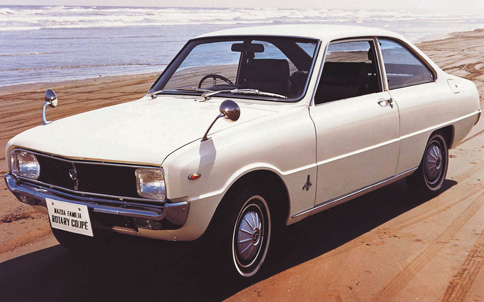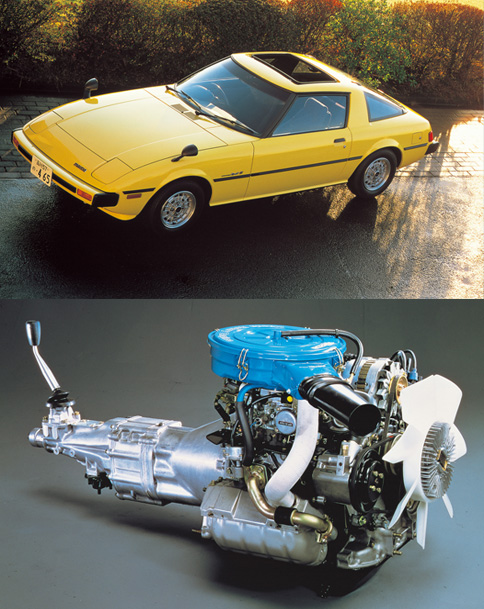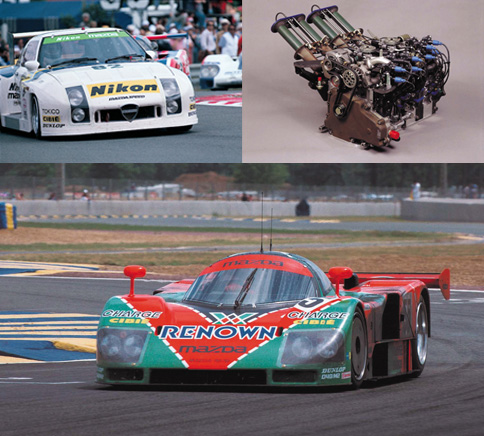Chapter II
Spirit of Tenacity Revives the Fortunes of the Rotary Engine
By launching the Cosmo Sport, the first rotary engine-powered car in the world, Mazda jolted more than just the Japanese market. In other countries, the news of the development of a practical rotary engine by a Japanese carmaker was received with surprise. Thus, Mazda demonstrated its technological prowess to the world.
In 1967, Japan was in the era of high economic growth. A bright future was awaiting Mazda, as Japan was in the midst of motorization, with national income growing rapidly and the expressway network starting to expand. In 1968, the Familia Rotary Coupe hit the road as the second rotary engine-powered car. Although the Familia was intended as a global strategic car, Mazda encountered a stumbling block in exporting this car to the United States, the first step of its global expansion.

Familia Coupe
To deal with the growing air pollution problem, the U.S. federal government introduced exhaust gas regulation in 1968. In 1970, the U.S. Congress passed the Clean Air Act, popularly known as the Muskie Act, which required a reduction of more than 90% in the amount of hydrocarbons contained in the exhaust gas from cars to be brought to market in 1975 and later. While a rotary engine emitted a relatively small amount of such harmful substances as nitrogen oxide, the amount of hydrocarbons emitted was relatively large. Therefore, the passage of the Clean Air Act dimmed the prospects of seeing rotary engine-powered cars running on American roads.
To overcome this problem, Mazda sought a technological breakthrough in a thermal reactor system, which burned hydrocarbon residue in the exhaust gas, and refined the system through innovation in terms of structure and material. In 1973, Mazda’s rotary engine passed a Muskie Act test conducted by the U.S. Environmental Protection Agency. In the same year, in Japan, the Luce AP (Anti-Pollution) was certified as the first car eligible for preferential tax treatment for low-pollution vehicles.

left:Familia Coupes being loaded for export
middle:Luce AP
right:A rotary engine fitted with a thermal reactor system

However, the way forward was still bumpy. Soon after we cleared the exhaust gas regulation hurdle in 1974, the first oil shock struck the world. This was a huge blow to rotary engine-powered cars, which were labeled as gas guzzlers because the fuel efficiency of rotary engines was relatively low in those days. Still, Mazda stuck with the rotary engine in the belief that continuing to make rotary engine-powered cars was its responsibility to society and duty of faith to its customers. To revive the fortunes of rotary engine-powered cars, the company launched the Phoenix Project in 1974, aiming to improve the rotary engine’s fuel efficiency by 40% in five years. With their spirit of tenacity, the engineers devoted themselves heart and soul to this project.
After an initial fuel efficiency improvement of 20%, a further breakthrough arrived when one engineer came up with the idea of reusing heat generated from the thermal reactor, which led to the development of a heat exchange system. As a result, Mazda achieved a total fuel efficiency improvement of more than 50%, surpassing the 40% target under the Phoenix Project. In Las Vegas in 1978, Mazda premiered the RX-7, a mass production rotary engine-powered sports car, marking the advent of a new era of rotary engines. The RX-7 competed in various motor races, including the 24 Hours of Le Mans and the World Rally Championship. In North America in particular, the RX-7 made a stunning debut, a class win, in the 24 Hours of Daytona race and accumulated victories over the following years. The successful track record in the motor sports world proved the RX-7’s good combination of speed and durability as a sports car and raised it to iconic status.
As for Le Mans, in which Mazda Auto Tokyo (which was the predecessor to Mazda Speed) started competing in 1974, the RX-7 finished the race for the first time in 1982. From 1983 onwards, Mazda continued to enter the race with a rotary engine-powered prototype RX-7. In 1991, Mazda’s motor sports endeavor culminated in the coveted “triple crown” in the ultimate endurance race with the 700-horse power, four-rotor rotary engine-powered Mazda 787B, after a dozen unsuccessful attempts over a period of 18 years from 1974. This marked the first overall victory in the Le Mans race for a Japanese carmaker.

Upper left: The first RX-7 to finish a Le Mans race
Upper right: Type R26B four-rotor rotary engine of 700-horse power installed on Mazda 787B
Lower:Mazda 787B

